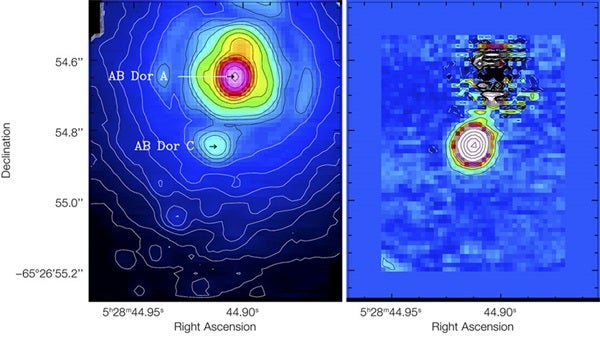Observing the image of a faint object near a star is a demanding task, as the object is generally hidden in the glare of the star. Characterizing this object by taking spectra is an even harder challenge. But thanks to a new ESO imaging spectrograph, this is feasible, paving the way to many thrilling discoveries.
These high-contrast observations are fundamental for directly-imaging unknown extra-solar planets (planets orbiting a star other than the Sun), as well as low-mass stars and brown dwarfs.
Astronomer Niranjan Thatte and his colleagues developed a new method for exactly this purpose. The basis of the concept is relatively simple: While the positions of many features associated with the host star and artifacts produced by the telescope and the instrument scale with the wavelength, the location of a faint companion does not. If the image has an internal reflection of the star masquerading as a planet, this phantom planet will be in one location when looking in red light, and another when looking in blue. A real planet will stay in the same place no matter what color of light one examines it in.
With the combined detection of spectra and position, one can see what is scaling, subtract it, and be left with the target dim object. Such observations can be done with ‘integral field spectrographs,’ such as the SINFONI instrument on ESO’s VLT. This technique, termed Spectral Deconvolution (SD), although first proposed in 2002 for space-based applications, has never been applied to obtain spectra of a real object until now.
“We applied our new technique to a puzzling, very small stellar companion — about twice the size of Jupiter — known as AB Doradus C, and the outcome was surprising,” Thatte says.
Using SINFONI and this new technique, astronomers can obtain a spectrum of the object free from the light of the brighter companion, containing all the information necessary for a complete classification.
The new observations lead to a new temperature for the object and change the results that scientists derived in 2005.
“This is how science progresses,” says Laird Close, leader of the science team. “New instruments lead to better techniques and measurements, which often lead to new results, and one must happily change course.”
The SINFONI observations were complemented with previous data obtained on ESO’s VLT with the NACO instrument.
AB Doradus is a system of two pairs of stars (four stars in total: a quadruple system), lying 48 light-years away toward the Doradus constellation (the Swordfish).
AB Doradus A is the young major member of this system and has a faint companion, AB Dor C, just 3 astronomical units (AU) away, or three times the distance between the Earth and the Sun. In our Solar System, this would be within the asteroid belt between the orbits of Mars and Jupiter.
AB Dor C was imaged for the first time, thanks to ESO’s VLT, in 2005. The other members of the system are the pair AB Doradus BaBb, located 133 AU from AB Dor A. While AB Doradus A has a mass about 85 percent that of the Sun, AB Doradus C is almost 10 times less massive than AB Doradus A, and is classified as a cool red dwarf.
Red dwarfs’ masses border masses of brown dwarfs. A precise knowledge of these stars is necessary in our understanding of stars’ evolution. If AB Doradus C were only slightly less-massive than its 93 Jupiter-mass, it would have been a brown dwarf, instead of a star. As it is, the center of AB Doradus C is slowly heating up. In about a billion years its core will become hot enough to begin fusing hydrogen into helium, something a brown dwarf will never do.
“This red dwarf is 100 million times closer to its brighter companion than the whole system is from us and about 100 times less bright. It is thus a perfect example where our very high contrast technique is
required,” says team member Matthias Tecza.
From previous observations, this unique star seemed to be cooler than expected for an object of such mass and age. The new, more precise observations show that this is not the case.
With a temperature of about 3,000 degrees (about half as hot as the Sun) and a luminosity about 1,000 times dimmer than the Sun, AB Doradus C lies on the exact track expected for a 75-million-year-old star with 9 percent of the Sun’s mass. AB Doradus C is the only such star (young and cool) with an accurate mass, hence the determination of an accurate temperature is critical for validating these models.
In the future, these tracks can be used to extrapolate the mass of small young stars, once their temperature and luminosity are precisely determined.
“Small stars are back on the expected track,” concludes team member Roberto Abuter.










